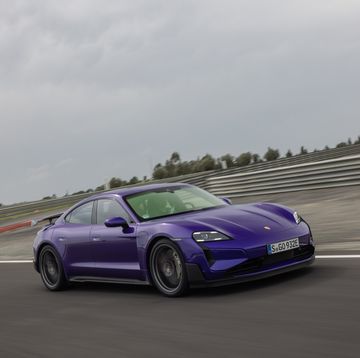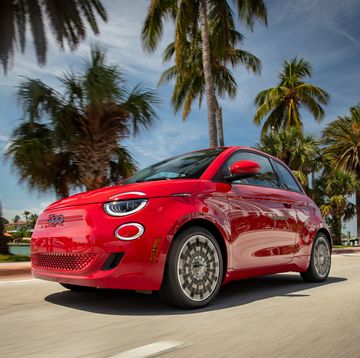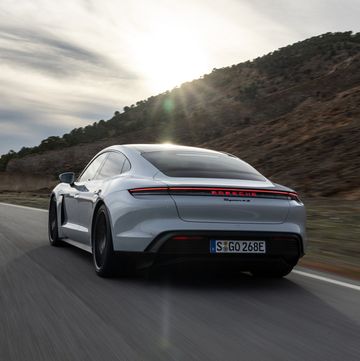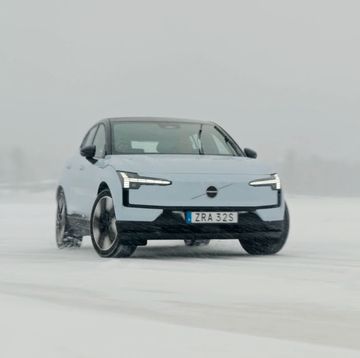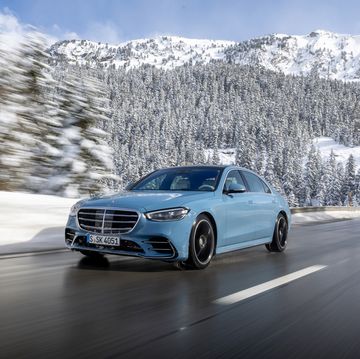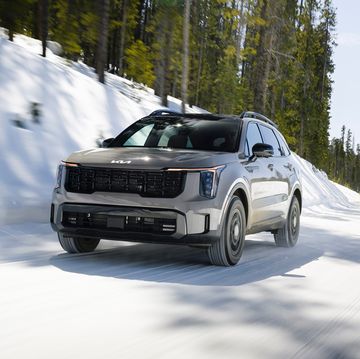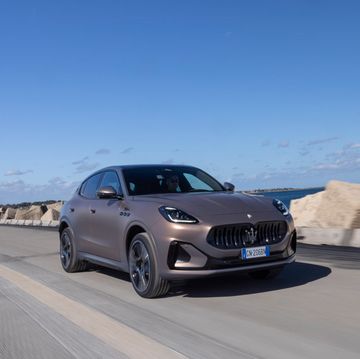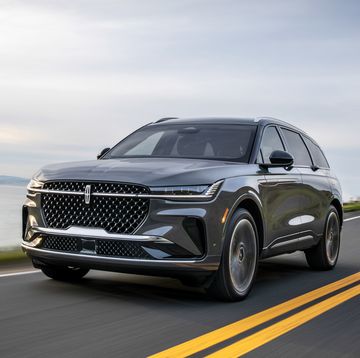Audi's Le Mans Quattro does more than celebrate the company's domination of the 24 Hours of Le Mans race between 2000 and 2002. In fact, it marks the beginning of a new design language for the corporation. See that grille? It's bigger and deeper than Audi grilles of yore, and according to Martin Ertl, Audi's head of design management, it signals the direction in which Audi design will go.
It was probably inevitable. Mercedes and BMW grilles went from tall and thin to short and squat. Audi's grille was always wide but short. So there was nowhere else to go. Otherwise, it seems to us, the contours of the Le Mans Quattro carry the suggestion of where Audi has recently been. The fastback rear deck is somewhat evocative of the TT coupe, although it's certainly larger and more muscular. And the front wheel arches advertise a familiar Audi design cue with their beveled appearance.
But it's a good-looking car if you can get used to the multi-LED headlights that stud the front end like the compound eyes of a 602-horsepower insect. On the car's flanks, the silver metal panel that extends from the door's rear shut-line to the side air-intake scoop is designed to emphasize the existence of an aluminum space frame under the sculpted carbon-fiber shell.
Initially, the designers responsible for the car's exterior-Frank Lamberty and Julian Hoenig-intended that metal panel to go all the way beyond the car's silhouette, where its upper edges would project like twin fins. But the idea was considered too fanciful, and it was dropped.
We think it's a good thing. That panel now fits like a jigsaw-puzzle piece, simultaneously accentuating the C-pillar and shortening what would have been a very long greenhouse. That design theme of metal projecting through a composite skin is in evidence elsewhere, too. You see the skeleton of the alloy space frame as spines in the engine compartment and as ribs inside the car. Even on the car's dashboard, there are elements that thrust through the surrounding high-tech-weave cabin cladding and jut provocatively into the occupants' view.
In line with this aggressive design is a return to the driver-oriented cockpit. All the controls and instruments are focused on the driver, and a high center tunnel further separates the occupants. It fits with the race-car atmosphere the designers were trying to create; yet Martin Ertl insists the Le Mans Quattro had to be the kind of car that would function in all the situations of modern life. That is, it would need to be able to blast its way through a mountain pass and then arrive at the country club for a reception to dignify its owner.
To that end the interior design is possibly the most groundbreaking aspect of the car. The cabin and the seats are covered in expensive-looking synthetic materials that recall the jigsaw effect of the side body panel, forming symmetrical shapes and patterns that tuck and butt up to one another with seamless perfection. In contrast, the high-tech instrument panel is almost mundane.
There's an analog tach on the left and a panel on the right that morphs (Ertl's word) from a digital representation of an analog clock to one of many readouts. Among them is a bird's-eye view of the Le Mans circuit (or any other that can be downloaded into the system), giving advance warning of which way the next curve goes. Ertl says the system could even provide advice as to what speed the driver could use for corner entries when properly programmed.
Audi's MMI (Multi Media Interface) uses that right-side display, too, for its usual plethora of settings and selections. The system's mouse ball has been integrated very adroitly, looking more high-tech than we've seen in other Audis. The flat-bottom steering wheel looks every bit like a race-car piece, especially with its buttons and gearshift paddles; and the sensation of moving one's hand from a woven surface to a cool metal section is a tactile reminder, again, of that concept of a metal skeleton under a plastic cover. It kind of brings Arnold's Terminator to mind.
Which is appropriate, given the exotic metal components under the elegant carbon-fiber skin. Sitting amidships under a hydraulically operated engine cover (it's shrouded beneath yet another plastic cover, where it can be seen through the backlight) is a direct-injected twin-turbocharged and intercooled version of the Lamborghini Gallardo V-10. The 5.0-liter, 40-valve, 90-degree engine is said to develop 602 horsepower in this incarnation, with a fairly impressive torque delivery of 553 pound-feet between 1750 rpm and 5800 rpm.
When asked whether this component shares any commonality within Audi's multistable empire, Ertl insisted the Le Mans's powertrain is more closely related to the R8 race car's. We know he compares them because of the shared direct-injection technology, but look here, Ertl, the Le Mans-winning Audi R8 employed a purpose-built V-8 engine, whereas this Le Mans has a V-10 hooked to a six-speed robotized manual that is obviously derived from the Gallardo.
Were the Le Mans to make it into production, one could easily imagine it would be motivated by the 330-hp, 4.2-liter V-8 from the Audi A8. A bit more energy could be found by using the 450-hp twin-turbocharged version of this engine from the RS 6.
We trundled this priceless prototype around the Streets of Willow in Southern California, and any talk of 602 horsepower was rendered academic by an insistence on low speeds and not much more than 2000 rpm. Would we say there was more than 500 pound-feet of torque available at those revs? We would not. Indeed, the calibrations of a concept car built to a harrowing show deadline are usually well south of a fully developed vehicle's.
But judging from the specifications-10 cylinders, two turbos, and five liters-and the sounds issuing from those dual tailpipes integrated into the rear fascia, we'd say the computer-estimated numbers are easily achievable. In the Le Mans concept, such power as there is is fed to the ground via big Goodyear F1 tires mounted to beautiful center-lock Ronal rims. The wheels hang from control arms at each corner. The front and upper rear arms are triangulated; the lower rear arms are trapezoidal in shape.
As in many cars of this type, the suspension comprises coil springs and shocks, but on the Le Mans, the shocks are filled with magnetorheological damping fluid, which changes its viscosity when a magnetic field is applied to it by an electromagnet in the shock piston. When sensors for speed, yaw, steering angle, et al., inform the chassis-control computer how the car is being driven, the damping force can be automatically varied according to driving conditions. Similar "magnetic ride" systems are already in production on various Cadillacs and Corvettes.
A Quattro all-wheel-drive system with a Torsen center differential apportions torque to the low-profile Goodyears-255/30ZR-20s in front, 295/ 30ZR-20s in back-in a 40/60-percent front-to-rear predisposition, but it's able to adjust that all the way to 30/70 if conditions require it. Huge ceramic discs handle braking. The fronts are 15.0 inches in diameter and have eight-piston calipers; the rears are 14.0-inch units gripped by six-piston calipers. They don't say Brembo anywhere, but then they don't have to.
With conventional doors, access to the passenger compartment is relatively easy. There's a fairly wide sill to cross, but there's also plenty of room for tall drivers, in both the legroom and headroom departments. The footwell is roomy, and the pedals are oriented in a natural, straight-ahead manner. In this car, even the four-point harness looks luxurious. All-around visibility is good, although the side mirrors are fashionably slim and don't reveal much area behind the car. We bet that would change in production.
That is, of course, if the reception this car meets warrants such a thing. We know from experience that Audi's concept cars are built with future production in mind, using existing technologies wherever possible to keep costs realistic. Audi already owns an aluminum-space-frame plant or two and has access to six-speed transmissions. Were this car built using versions of Audi V-8s, it might sell for less than $100,000, maintaining proper marketing spacing from the Gallardo and providing strong competition for the likes of the Porsche 911.
If that thought appeals to you, now is the time to let Audi know.


